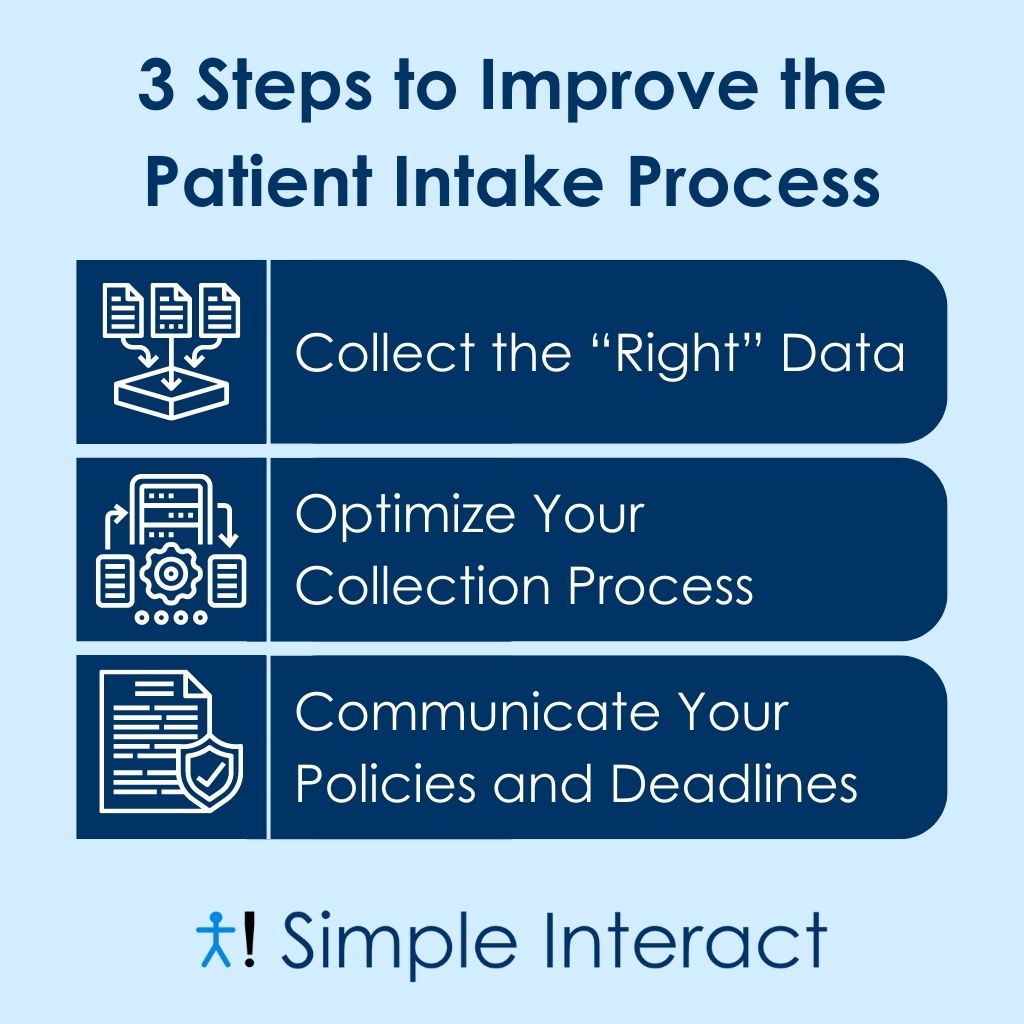How to Speed Up Your Patient Intake Process

Few things are more frustrating to a healthcare facility than a slow patient intake process. When patient intake is inefficient, your staff, patients, providers, and bottom line all suffer. And that’s a big problem.
It’s also one that’s frustratingly difficult to solve without the right tools.
To identify ways of improving the patient intake process, let’s first run through a quick audit of the patient intake path to identify problem areas and slowdowns.
The Slow Patient Intake Process
Even patients who show up on time or just a few minutes late can contribute to a slow patient intake process. The time needed to check in, ask questions, and fill out required (often poorly designed) intake forms occupies at least 10–15 minutes, effectively making the patient who arrived on time a quarter hour late for their actual appointment slot.
When the patient hands their forms in, the front desk staff may need to enter some of that data into the Practice Management System, which adds more time. Then, they hand the forms off to the medical assistant, who needs to enter medical history data into the patient record in the EMR. If the patient has illegible handwriting or provides incomplete information, it leads to further delays.
Finally, the provider can see the patient.
It’s easy to see that improving the patient intake process would positively affect many aspects of practice operations and patient experience.
The Consequences of a Slow Patient Intake Process
All this excess effort is taking place on your time and your dime.
You’re having to pay staff for the additional time it takes to do all that manual data entry and shuffling of papers. They may even have to stay late to catch up on tasks, which can increase burnout and require overtime pay.
Many times, your providers end up waiting between appointments while front office staff process patient information, which means wasted time and lower provider utilization.
Patients experience longer wait times, even when they arrive early for their appointments. We all know long wait times lead to lower patient satisfaction and higher frustration rates, which impact your reputation and patient retention.
All these delays make keeping to the appointment schedule difficult. If your providers want any hope of staying on schedule, they have to shave time off each appointment. This means a lower impact on patient health and a less satisfying patient experience.
A slow patient intake process is frustrating for everyone — providers, staff, and patients alike.
Improving the Patient Intake Process
Fortunately, three clear steps can improve the patient intake process.

Step #1 — Collect the “Right” Data
With new patients, it’s tempting to collect as much information as possible during the intake process. But this approach has a huge downside. There’s a difference between helpful, necessary data and too much data. Find balance by prioritizing quality over quantity.
When you ask for too much information, patients may simply refuse to provide it. They may leave fields blank or fill them in incorrectly, and the quality of the data you get drops significantly.
Prioritize quality data and find the balance between what’s enough, what’s essential, and what simply isn’t necessary.
Step #2 — Optimize Your Collection Process
You can improve a slow patient intake process by optimizing how you collect data from patients.
Asking patients to show up early for appointments to fill out forms often doesn’t yield consistent results. Instead, ask patients to complete and turn in forms well before their appointments. Sending patients digital intake forms ahead of time streamlines the process and increases compliance significantly more.
If you and your staff are still using paper forms and aren’t ready to switch to digital, it can help to mail forms to patients before their appointments so they arrive with everything filled out.
Digital intake forms are the most effective thing you can do to improve a slow patient intake process. That said, make sure your forms are mobile-friendly and work across a variety of devices. This way, patients can fill them out on their smartphones, tablets, or laptops — whatever they find most convenient.
Step #3 — Communicate Your Policies and Deadlines
Effective communication of policies and deadlines also plays a role in improving the patient intake process. Ensure your patients know the policies of your healthcare establishment, as well as any relevant deadlines, well ahead of their scheduled appointment.
You might include this information in a welcome letter to your patient. Take care to make the information crystal clear, stating deadlines and any necessary protocols, such as your cancellation policy. You can communicate plainly that the provider expects filled-out forms when patients arrive in the office or by a specific pre-appointment deadline. It’s also crucial to have a reminder mechanism in place for helping patients remember to fill out their forms on time.
Make it as easy as possible for your staff to share all the necessary forms with patients in a timely fashion. Simply clicking a button to send a text or email reminder with a link to the forms is much more efficient than needing to package and mail forms off to a patient who has lost them.
Conclusion
A slow patient intake process is more than frustrating — it’s costly. When you prioritize improving the patient intake process, you’ll make strides toward a more successful and profitable business. It’s a journey worth taking!
If you’d like to learn about Simple Interact’s digital patient intake tools, reach out. We’d love to talk!

Ravi Kalidindi is the Founder and CEO of Simple Interact, a leading Front Office Automation company that helps healthcare facilities across the United States run more efficiently and profitably by boosting staff productivity, reducing provider burnout, and elevating the patient experience. Customers view Ravi as a trusted partner who can quickly comprehend business problems and suggest “keep it simple” solutions that are effective and easier to maintain over time.
Recent Posts
- The Benefits of Using 2-Way SMS Chat for Healthcare Communication
- 2-Way SMS vs. Live Chat: Which Is Best for Bi-Directional Patient Communication?
- Simple Interact Earns A+ Satisfaction Ratings in KLAS Report
- Boosting Healthcare Staff Productivity With a Shared Inbox Dashboard
- Healthcare SMS: What Metrics to Track in Your 2-Way SMS
Categories
Archives
- February 2025
- June 2024
- May 2024
- April 2024
- March 2024
- February 2024
- January 2024
- December 2023
- November 2023
- October 2023
- September 2023
- August 2023
- July 2023
- June 2023
- May 2023
- April 2023
- March 2023
- February 2023
- January 2023
- December 2022
- November 2022
- October 2022
- September 2022
- August 2022
- July 2021
- December 2020
- May 2020
- March 2020
- June 2016